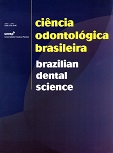Relation Between the Craniocervical Cephalometric Analysis and Class I, II and III Skeletic Patterns in Young Subjects
DOI:
https://doi.org/10.14295/bds.2012.v15i1.739Keywords:
Crânio, Postura, Radiologia, CefalometriaAbstract
The skull posture on the spine is an important factor for the diagnosis of craniomandibulars functional disorders in children, as well as in adults. Alterations in biomechanics may be evidenced in common x-rays. The aim of this study was to relate findings of craniocervical analysis with skeletal pattern Class I, II, III in individuals from 7 to 12 years old. X-rays of 92 individuals were taken by NHP method and digitalized for computerized analysis of skeletic patterns and craniocervical analysis. Descriptive analysis was used to relate craniocervical analysis values with the type of skeletal pattern presented by individuals. For skeletal pattern Class I, II and III, nasopharyngeal soft tissue percentage and oropharyngeal soft tissue linear quantity were above normality value; nasopharyngeal cervical plot was normal and hyoid triangle was positive for the majority of the individuals. The angular relationship between skull and cervical spine show values lower than those considered normal for skeletal pattern class I and II. It was concluded that in the majority of the individuals with skeletal pattern Class I, II and III had high values of airway blockage, head posterior rotation, nasopharyngeal cervical plot with normal values and positive hyoid triangle.
Downloads
Downloads
Additional Files
Published
How to Cite
Issue
Section
License
Brazilian Dental Science uses the Creative Commons (CC-BY 4.0) license, thus preserving the integrity of articles in an open access environment. The journal allows the author to retain publishing rights without restrictions.
=================




























